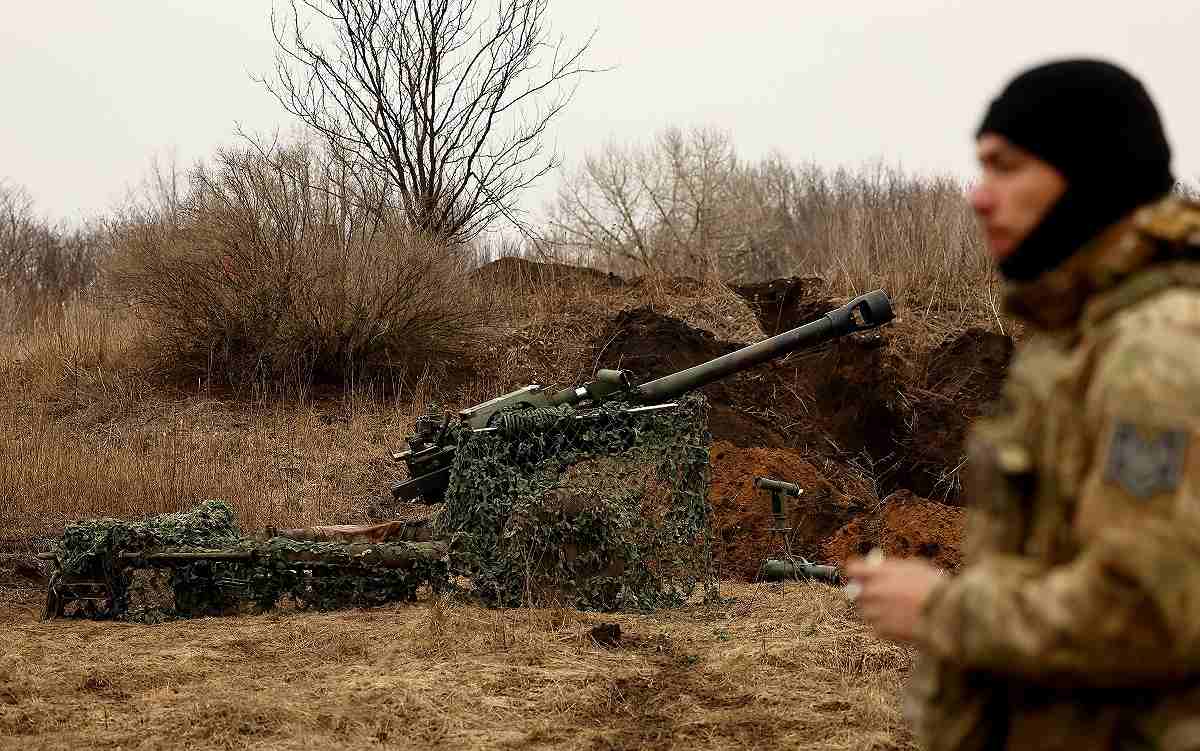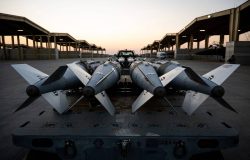
A Ukrainian serviceman waits for order to fire a M119 howitzer near the frontline town of Bakhmut amid Russia’s attack on Ukraine, Donetsk region, Ukraine March 8.
10:39 JST, March 9, 2023
KYIV, March 8 (Reuters) – The head of Russia’s Wagner mercenary group said on Wednesday his fighters had captured all of the eastern part of Bakhmut, and NATO’s secretary general said the rest of the Ukrainian city could fall to the invading army in the next few days.
But as one of the bloodiest battles of the year-long war ground on amid the ruins, Ukrainian defenders – who last week appeared to be preparing for a tactical retreat from Bakhmut – remained defiant.
Ukrainian military and political leaders now speak of hanging on to positions and inflicting as many casualties as possible on the Russians to grind down their fighting capability.
The General Staff of Ukraine’s armed forces said in its Wednesday morning report: “The enemy, despite significant losses, continues to storm the town of Bakhmut.”
Wagner boss Yevgeny Prigozhin said his fighters, who have been spearheading the assault on Bakhmut, had now captured the city’s east. If true, that would mean Russian forces now control nearly half the city in their costly push to secure their first big victory in several months.
“Everything east of the Bakhmutka River is completely under the control of Wagner,” Prigozhin said on Telegram.
The river bisects Bakhmut, which sits on the edge of a swathe of Ukraine’s Donetsk province that is already largely under Russian occupation. The city center is on the west side of the river.
Prigozhin has issued premature success claims before and Reuters was not able to verify the situation on the ground.
Speaking before a meeting of European Union defense ministers in Stockholm, NATO Secretary-General Jens Stoltenberg said Russia was throwing more troops into the battle.
“They have suffered big losses, but at the same time we cannot rule out that Bakhmut may eventually fall in the coming days,” Stoltenberg said.
This would not necessarily be a turning point in the war, he added, but it showed “we should not underestimate Russia.”
On Tuesday near Bakhmut, a Ukrainian National Guard chief medic who gave his name as Artem told Reuters that all roads out of the city were under constant heavy shelling.
“Ambulances and other vehicles come under shelling and for that reason it is very difficult to evacuate people. There are high losses, and among medics in particular,” he said.
Devasted cities
Russia, which says it has annexed nearly 20% of Ukraine’s territory, says that taking Bakhmut would be a step towards seizing the whole of the eastern industrial Donbas region.
Western analysts say Bakhmut has little strategic value, although its capture would be a boost to Russian President Vladimir Putin and his military after a series of setbacks in what they call their “special military operation.”
Kyiv says the losses suffered by Russia there could determine the course of the war, with Ukraine expected to launch a counteroffensive when the weather improves and it receives more Western military aid, including heavy battle tanks.
The months of warfare in the east have been among the deadliest and most destructive since Russia invaded in February 2022, adding Bakhmut’s name to a list of devastated cities such as Mariupol, Sievierodonetsk and Lysychansk.
A Ukrainian military drone showed the scale of destruction in Bakhmut, filming apartment blocks on fire and smoke billowing from residential areas.
Iryna Vereshchuk, a deputy Ukrainian premier, said fewer than 4,000 civilians – including 38 children – out of a pre-war population of some 70,000 remain in Bakhmut.
“The situation in the city is difficult. The enemy actively storms our positions. However, they don’t have any success and suffer colossal losses,” a Ukrainian border guard said in a video released by the State Border Service.
U.S. Director of National Intelligence Avril Haines, the main intelligence adviser to President Joe Biden, described the fighting in Ukraine as “a grinding, attritional war.”
Speaking as the Senate Intelligence Committee began its annual hearing on threats to U.S. security, Haines said U.S. intelligence did not foresee the Russian military recovering enough this year to make major territorial gains.
Russia casts its invasion of Ukraine as a response to threats to its security from its neighbor’s ties to the West.
Arms buying push
The EU defense ministers meeting in Stockholm agreed to speed up the supply of artillery rounds and buy more shells to help Ukraine.
Under a plan drawn up by foreign policy chief Josep Borrell — the details of which still have to be worked out — EU states would get financial incentives worth 1 billion euros to send more of their artillery rounds to Kyiv, while another 1 billion euros would fund joint procurement of new shells.
Ukrainian Defence Minister Oleksii Reznikov, who attended the Stockholm talks, said Kyiv needed 90,000-100,000 artillery rounds per month. Ukraine’s military is currently burning through shells faster than its allies can manufacture them.
In a separate diplomatic development, Ukraine’s president and U.N. Secretary-General Antonio Guterres called for the extension of a deal with Moscow that has allowed Ukraine to export grain via Black Sea ports.
President Volodymyr Zelenskiy said after talks with Guterres in Kyiv that the Black Sea Grain Initiative was “critically necessary” for the world, and the U.N. chief underlined its importance to global food security and food prices.
Top U.N. trade official Rebeca Grynspan will meet senior Russian officials in Geneva next week to discuss extending the deal, a U.N. spokesperson said.
"News Services" POPULAR ARTICLE
-

American Playwright Jeremy O. Harris Arrested in Japan on Alleged Drug Smuggling
-

Japan’s Nikkei Stock Average as JGB Yields, Yen Rise on Rate-Hike Bets
-

Japan’s Nikkei Stock Average Licks Wounds after Selloff Sparked by BOJ Hike Bets (UPDATE 1)
-

Japanese Bond Yields Zoom, Stocks Slide as Rate Hike Looms
-

Japan’s Nikkei Stock Average Buoyed by Stable Yen; SoftBank’s Slide Caps Gains (UPDATE 1)
JN ACCESS RANKING
-

Keidanren Chairman Yoshinobu Tsutsui Visits Kashiwazaki-Kariwa Nuclear Power Plant; Inspects New Emergency Safety System
-

Imports of Rare Earths from China Facing Delays, May Be Caused by Deterioration of Japan-China Relations
-

University of Tokyo Professor Discusses Japanese Economic Security in Interview Ahead of Forum
-

Japan Pulls out of Vietnam Nuclear Project, Complicating Hanoi’s Power Plans
-

Govt Aims to Expand NISA Program Lineup, Abolish Age Restriction























